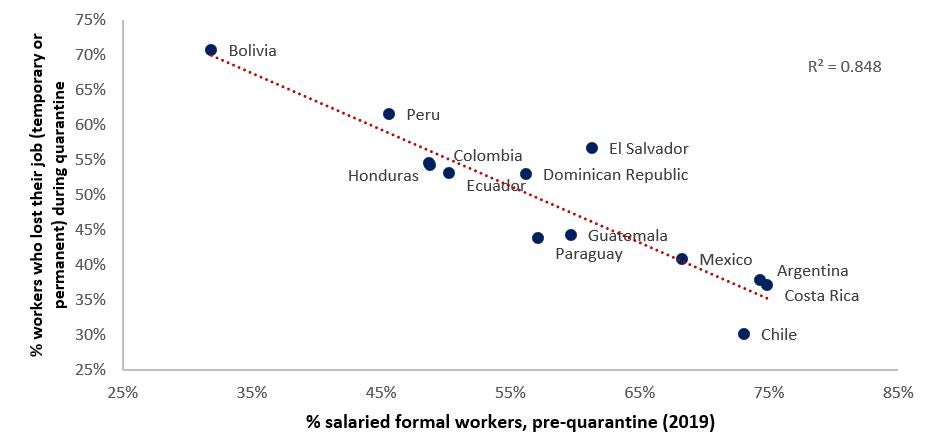 Employment nationwide decreased by 40% in the second quarter of this infamous year 2020.
Employment nationwide decreased by 40% in the second quarter of this infamous year 2020.
Peru is one of the countries in the region most affected by the pandemic, both in terms of declines in economic activity and in terms of rates of infection and deaths from the disease. On the economic side, unemployment and informality increased significantly, wages and working conditions deteriorated, and many companies were unable to stay afloat. All of this has been further aggravated by the political situation (three presidents in a week) and the growing division among political leaders.
But the economic symptoms that Peru is suffering from are largely the result of pre-existing conditions. For instance, informality was very high in Peru before the pandemic, and not only has it worsened after the severe quarantine was implemented earlier this year, but it also aggravated the labor market situation.
Figure 1: Loss of Jobs (temporary/permanent) and percentage of formal workers prior to the lockdown

We see that pre-existing structural characteristics of the Peruvian labor market - low quality jobs characterized by being mostly informal and concentrated in low productivity sectors - contributed to massive unemployment at the onset of the crisis and slow recovery thereafter. Employment nationwide decreased by 40% in the second quarter of this infamous year 2020. This means that more than 6 million people lost their jobs during this period; some of them permanently while others temporarily. Most of the job losses, in nominal terms, occurred in large cities and urban areas; especially in Lima and Arequipa, where labor markets are larger and more dynamic, but also in other cities such as Ica and Tacna. The patterns in rural areas are also worrying; Although most people living in these areas kept their jobs, many experienced a general decline in income because they had to switch from paid work to underpaid or unpaid (subsistence) work.
As in most crises, younger workers (under 35) and women were 15% and 10% more likely to lose their jobs than older workers and men, respectively. Unlike other periods of crisis, essential workers (those deemed to be in economic subsectors such as health, utilities, banking, logistics, security) were significantly less affected by job losses (23% more likely to keep their jobs) than their peers in non-essential sectors; regardless of age and gender.
The availability of public transportation also played an important role in whether a person kept their job or not. Based on the provisions of Supreme Decree 044-2020, public transportation was limited to 50% of its capacity in Lima and Callao, as well as in other regions of the country. As one would expect, only transport companies capable of meeting specific rules and regulations (many of them quite onerous) could continue to provide transportation services. However, a large segment of the transport sector in Peru operates informally (and with low profit margins); thus, most were unable to comply with the strict regulations (for example, reduced number of passengers, or sanitary conditions) imposed by the government. Therefore, the availability of means of public transport decreased dramatically, and as a result, workers dependent on public transport were unable to go to work and lost their jobs.
Those who owned a car experienced lower employment losses, although car ownership is highly correlated with one's financial situation and type of job. This finding indicates the importance of supporting improvements in the availability of safe and trustworthy public transport services in the recovery stage as well as in the future. Doing so will not only help to ensure workers can safely access work and economic opportunities as the economy recovers but also improve the quality of public transport and its resilience in the future.
Many have speculated that if most workers had access to broadband and telecommuting-friendly jobs, they would have been equipped to work from home and, as a result, would have been more likely to keep their jobs; especially in urban areas. And indeed, Figure 2 shows that there is a clear positive correlation between job retention and the ability to work from home. However, a closer look at this relationship shows that the high prevalence of informality and the high concentration of workers in low-productivity (mostly informal) jobs throughout the economy, eliminates the positive impacts that connectivity and the type of tasks required by the occupation can lead to job retention.This indicates that, due to the omnipresent nature of informality, despite all the advances in connectivity in urban areas in the country, the negative effects of the strict quarantine on employment were not mitigated in Peru (as observed in other countries in the region and the world).
Figure 2: Possibility to work from home and variability in employment

The evidence of how informality aggravated the situation of vulnerable workers in the Peruvian labor market is clear. Even though many workers will re-enter the economy through informal jobs, it will be important to ease their transition out of the informal sector as quickly as possible (or skip it altogether) to improve their resilience to future shocks. Through this blog, we highlight the importance of addressing informality in any economic reactivation strategy. Peruvian legislators acted quickly and effectively at the beginning of the crisis, to protect informal workers and prevent them from falling into poverty. But now, as we move into the reactivation stage, it will be essential to focus our efforts to reduce this critical structural vulnerability and to take decisive steps to boost formality once and for all.




Join the Conversation